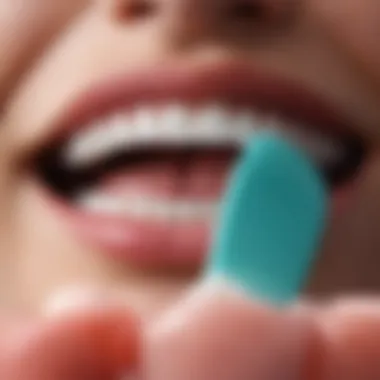The Color in Toothpaste: Science & Marketing Insights


Intro
Toothpaste serves as a daily essential in many household routines, yet its vibrant colors often go unnoticed. This article aims to untangle the intricate relationship between the colors of toothpaste and their impact on consumer choices. We will explore how colors play a crucial role not only in aesthetics but also in perceived effectiveness. Understanding the unique formulations that contribute to hues, the marketing strategies employed by leading brands, and the psychological aspects tied to color perception can deepen our appreciation for this everyday product.
Engaging with the science of toothpaste colors sheds light on why specific shades are favored and how they influence our daily dental care. By addressing the potential health implications tied to various dyes and analyzing trends in consumer behavior, this exploration seeks to provide a comprehensive view on the often-overlooked world of toothpaste color.
Prelims to Toothpaste Color
Understanding the color in toothpaste is essential for both consumers and manufacturers. Colors play a role that extends beyond mere aesthetics; they can influence purchasing decisions and perceptions about effectiveness. This section aims to outline the historical context and purposes of toothpaste colors to provide a thorough foundation.
Historical Context of Toothpaste
Toothpaste has evolved significantly since its inception. The early versions date back to ancient civilizations, where people used abrasive substances combined with various natural ingredients to cleanse their teeth. These mixtures lacked any distinct color. However, as dental hygiene became a field of scientific study, several developments led to the introduction of colors in toothpaste formulations.
In the 20th century, commercial toothpaste brands began to emerge, introducing vibrant colors to differentiate their products. For example, brands like Colgate and Crest started using red and white stripes to create a visually appealing product that caught consumers' eyes. This trend has continued, with toothpaste colors often indicating specific formulations, such as whitening or sensitivity relief.
Purpose of Toothpaste Colors
The colors used in toothpaste serve multiple purposes. First and foremost, they provide a visual cue for consumers. Bright colors may suggest freshness or potency, enhancing appeal on the shelf. Additionally, colors can indicate diverse formulations. For instance, certain hues may imply that the product addresses specific dental issues, such as plaque removal or enamel protection.
Moreover, colors play a role in marketing strategies. Companies often use color psychology to influence buyer behavior. Consumers tend to associate colors with emotions and experiences. Blue usually evokes feelings of calmness, while green is often linked to natural ingredients. These associations can impact decisions, making some colors more effective than others in attracting customers.
In summary, the historical context and purposes of toothpaste colors reveal a layered understanding. These aspects underline the importance of color as a functional and marketing tool in the dental product landscape.
Chemical Composition and Dyes
The chemical composition of toothpaste is essential to understand not only for discerning its cleaning capabilities but also for grasping the role of colors and dyes. Colors in toothpaste serve various purposes, from aesthetic appeal to functional indicators. Each dye used can have different properties, benefits, and implications for user experience. The inclusion of colors is deliberate and tied to both marketing strategies and consumer perceptions.
Types of Dyes Used in Toothpaste
Toothpaste utilizes various dyes and colorants, each chosen for specific reasons. The most common category includes synthetic dyes like FD&C Blue No. 1, which provides a vivid blue hue, and FD&C Red No. 40, to impart a bright red tone. These dyes are often preferred due to their stability and ability to maintain color through the product's shelf life.
Natural dyes are also gaining popularity. Colors derived from beet juice or turmeric are examples. These are favored for their perceived health benefits. Users are increasingly leaning towards natural ingredients, prompting brands to reformulate their products.
Some manufacturers may choose no coloring agents at all, opting for a more transparent or off-white appearance. Each choice reflects a distinct target market and brand philosophy.
Regulatory Standards for Dyes
Dyes used in toothpaste must comply with strict regulatory standards to ensure consumer safety. In the United States, the Food and Drug Administration (FDA) oversees the approval and use of color additives. Only dyes certified for safety under specific conditions can be included in toothpaste formulations.
While synthetic dyes undergo rigorous testing, some natural colorants also face regulations. Their origin and processing must be documented to confirm safety. The emphasis on these standards is crucial, as not complying can lead to public health risks.
"Dyes and colorants in dental care products impact not only product perception but also user trust in what they apply to their oral hygiene routine."
In summary, the chemical composition and choice of dyes in toothpaste play a significant role beyond mere aesthetics. Brands are challenged not only to meet consumer desires for vibrant colors but also to ensure safety and compliance with regulations.
Color and Psychological Impact


The perception of color plays a significant role in shaping consumer behavior. Understanding color psychology can enhance marketing strategies in various sectors, including dental care. In toothpaste marketing, the colors chosen influence consumer trust, product appeal, and even perceived effectiveness. By delving into the psychological aspects, we can appreciate how colors serve not only aesthetic but also functional roles.
The Psychology of Color in Marketing
Emotional Responses to Color
Colors evoke emotional reactions that can affect purchasing decisions. Blue, for example, often calms people, which can lead to an inclination towards products that promise more pacifying benefits, such as sensitivity toothpaste. When consumers see such colors, they might subconsciously associate them with reliability and safety.
These associations make emotional responses to colors a powerful aspect of marketing. The more vivid or popular the color, the stronger the impact. Consumers may feel more drawn to bright colors, believing they signify effectiveness or freshness. Thus, toothpaste brands often choose bright colors to resonate with these feelings, appealing to consumers seeking superior products. While emotional responses can enhance visual appeal, over-saturation with bright colors may cause fatigue or annoyance.
Branding Strategies Based on Color
Branding heavily relies on color to convey messages and create differentiation in the market. For example, green is often associated with natural ingredients, appealing to consumers focused on eco-friendly products. Brands like Tom's of Maine use green to emphasize their natural toothpaste formulations. This strategy effectively communicates the brand’s values and attracts like-minded consumers.
Moreover, color can create brand loyalty. When consumers associate specific colors with enjoyable experiences, they are more likely to choose the same product repeatedly. Yet, there is a risk; if a brand frequently changes its color scheme, it may confuse loyal customers. Hence, consistency in color choice is crucial for effective branding.
Consumer Preferences and Perceptions
Consumer preferences regarding toothpaste colors can significantly influence purchasing decisions. Colors not only reflect personal taste but also signal perceived effectiveness of the product.
Popular Colors and Trends
Recent trends show that consumers are leaning towards pastel colors, seen as gentler and more approachable. These softer hues can appeal to families, likely because they suggest a caring aspect to dental care. Bright whites continue to signify cleanliness and freshness while darker shades often signify premium products. By staying attuned to these trends, brands can tailor their products to meet evolving consumer expectations, thus maintaining relevance in a competitive market.
Influence of Social Media on Color Choices
The rise of social media has revolutionized how products are marketed and chosen. Platforms like Instagram present visual content where colors play a vital role in attracting attention. Users often share their choices, influencing others to prefer certain toothpaste brands based on their color. A vibrant or uniquely colored toothpaste may gain popularity through social evidence and aesthetic appeal.
However, following trends can pose challenges. What is trendy today may be outdated tomorrow. Brands must manage their palettes wisely to keep pace with these changing dynamics while retaining core brand identity.
"Colors are more than just a visual element; they communicate messages and influence emotional connections."
Understanding the psychological impact of color can lead to more informed consumer choices and improved marketing strategies within the toothpaste industry. Brands can benefit from recognizing these dynamics and adapt accordingly to capture the attention of discerning consumers.
Functional Benefits of Color
The role of color in toothpaste extends beyond mere aesthetics. It serves multiple functional benefits that can influence consumer choice and perceptions. By utilizing specific colors, manufacturers can signal the purpose and attributes of their products. This understanding enhances the usability of toothpaste, guiding users toward the products that best suit their dental needs.
Color Indicators for Different Toothpaste Types
Whitening vs. Sensitivity Toothpastes
Toothpaste designed for whitening often exhibits bright colors, like blue or white. These colors not only attract the consumer's eye but also imply brightness and cleanliness. Whitening toothpaste typically includes added chemical agents, it aims to remove stains and enhance tooth luster.
On the other hand, sensitivity toothpastes frequently feature softer hues, such as pastel shades. This visual choice suggests gentleness and care. The key characteristic of sensitivity toothpaste is its formulation designed to soothe nerve endings and minimize discomfort during brushing. Its unique appeal lies in addressing specific dental concerns, making it a favored choice for individuals with sensitive teeth.
When consumers select a toothpaste, they are often subconsciously influenced by these color cues. Therefore, both whitening and sensitivity toothpastes effectively utilize color to communicate their benefits and attract the appropriate audience.


Natural vs. Conventional Toothpaste
In the realm of oral health products, there is a growing trend towards natural toothpastes. These products often showcase earthy tones like green or beige. Such hues signify organic ingredients and resonate with consumers who prioritize environmental sustainability. The key aspect of natural toothpaste is its reliance on plant-derived ingredients and lack of harsh chemicals.
Conversely, conventional toothpastes tend to feature bright and bold colors, reflecting their widespread consumer accessibility. They often include various synthetics to enhance flavor and achieve desired stability. While both types serve effective cleaning purposes, their color choices help delineate between natural and traditional brushing options, catering to diverse user preferences.
The functional benefits of these colors offer insights into consumer desires and expectations. Observing color in toothpaste not only reveals marketing strategies but also supports informed decisions in oral hygiene products.
Scientific Evidence Behind Color Functions
Research indicates that color can affect user compliance and satisfaction with dental products. Different trials show how consumer perceptions are often aligned with advertised colors. In a study, participants displayed preferences toward colors resembling health and freshness. Bright colors were found to promote perceived effectiveness in cleaning and taste.
Moreover, a correlation between color and ingredient effectiveness is emerging. Some studies suggest that the colors used may have an impact on the perceived efficacy of active agents.
In summary, understanding the functional benefits of color in toothpaste helps in discerning consumer behavior and product effectiveness. It reveals underlying marketing principles while emphasizing the significance of choice in tooth care.
Health and Safety Considerations
Understanding health and safety in relation to toothpaste colors is crucial. This segment explores the potential allergic reactions associated with dye usage and discusses the effects of long-term exposure to artificial dyes. Both aspects impact not only consumer awareness but also product development in the dental care industry. Therefore, examining this topic helps consumers make informed decisions about their dental hygiene products.
Allergic Reactions to Toothpaste Colors
Identifying Symptoms
Toothpaste colors can cause allergic reactions in some individuals. Common symptoms include redness, itching, or swelling in the mouth area. These symptoms may present themselves shortly after using the product. It is essential to recognize these reactions promptly, as they can lead to more severe issues like mouth sores or even anaphylactic reactions in rare cases. The key characteristic of recognizing symptoms is its preventative aspect; early identification may prevent complications from occurring. Because the mouth is sensitive, these reactions could lead to discomfort and disrupt daily routines. Thus, effectively identifying symptoms contributes significantly to a safe dental care regimen.
Alternatives for Sensitive Users
For those who experience allergic reactions, alternatives to conventional dyes are available. Products labeled as "dye-free" often use naturally-derived ingredients instead of artificial colorants. This characteristic appeals to users seeking safer options for their oral hygiene products. Natural formulations reduce the risk of irritation and are a beneficial choice for sensitive users. Moreover, these alternatives often come with added benefits like natural flavors, which enhance user experience without compromising safety. However, potential disadvantages include a limited range of colors and possibly reduced shelf appeal due to the absence of vibrant hues.
Long-term Effects of Artificial Dyes
The use of artificial dyes has raised concerns regarding their long-term health effects. Some studies suggest that prolonged exposure to certain synthetic dyes might be linked to health issues, though evidence is not conclusive. Consequently, consumers are increasingly cautious when choosing dental care products. Recognizing these long-term effects is important as it influences purchasing decisions and brand loyalty. This scrutiny also compels manufacturers to explore safer alternatives. When consumers are educated on the potential impacts of these dyes, they are more likely to advocate for change in product formulations.
"Awareness of allergic reactions and health concerns regarding artificial dyes in toothpaste encourages consumers to seek safer dental care options."
Culmination
In summary, health and safety considerations around toothpaste colors are critical. Allergic reactions can significantly impact users, necessitating the identification of symptoms and the availability of alternatives for sensitive individuals. Additionally, awareness of long-term effects of artificial dyes may shape consumer preferences, driving demand for more natural products. Addressing these elements not only enhances individual health but also fosters a more responsible approach to toothpaste formulation.
Cultural Variations in Toothpaste Colors
Understanding the cultural variations in toothpaste colors is essential for grasping how consumers globally interact with this everyday product. Cultures have distinct associations with colors, which influence their preferences and purchasing decisions. This section delves into the specific regional preferences and the cultural significance of colors in toothpaste, reflecting broader social and psychological implications.
Regional Preferences in Toothpaste Colors
Toothpaste colors can vary significantly depending on the region. Different countries may favor certain shades based on local customs and beliefs. For instance, in some Asian markets, bright colors such as blue and green may indicate freshness and efficacy. In contrast, more subdued colors may be popular in European countries, reflecting a perception of sophistication or naturalness.


- Asia: Bright colors and vivid packaging capture attention. Popular shades include vibrant pinks and greens, often associated with fruity or herbal flavors.
- North America: Preference leans towards traditional white with some blue and green options, emphasizing a clean and professional image.
- Europe: Bottom-line color choices might be paler shades, which suggest purity and simplicity, often appealing to health-conscious consumers.
- South America: Bright colors reflect joy and energy. It is common to find products marketed with vivid colors that resonate with local cultures.
Cultural Significance of Colors
Colors carry profound meanings and connotations in various cultures, extending beyond mere aesthetics. In the context of toothpaste, these associations can affect consumer behavior.
For example:
- Red: Often viewed as a sign of danger or alertness in Western societies, it may also be connected to passion and vitality in Latin cultures. This dual perception can influence the effectiveness of marketing campaigns.
- Green: Associated with nature and health, particularly in Western cultures, green is often used to indicate that a product contains natural ingredients.
- Blue: Typically signals trust and reliability, making it a popular choice for dental hygiene products aiming to convey safety.
- Yellow: This color is often linked to happiness and energy across cultures, but can represent caution in certain contexts.
"Color serves not just as a marketing tool, but as a connection to the deep-seated values within cultural narratives."
In summary, cultural variations in toothpaste colors offer a lens through which to view consumer preferences and behaviors. Recognizing these differences is essential for marketers who seek to tailor their strategies to specific populations, ensuring their products resonate effectively across diverse cultural landscapes.
Innovations in Toothpaste Formulation
Innovations in the formulation of toothpaste have become increasingly significant in recent years. The shift towards natural ingredients and eco-friendly products reflects a broader consumer demand for transparency and sustainability. This section will explore the factors contributing to these innovations, the implications for consumer choices, and potential health benefits associated with natural formulations.
The Role of Natural Colors in Toothpaste
The trend towards natural ingredients extends to the colors used in toothpaste. Traditionally, synthetic dyes have dominated the market. However, consumers are now showing a preference for natural colors derived from plant-based sources. Ingredients like beetroot powder, spirulina, and turmeric are gaining popularity due to their perceived health benefits and the absence of artificial additives.
Natural colors not only align with consumer preferences but also contribute to a broader narrative of health and wellness. Consumers are more likely to choose products that they perceive as safe and beneficial. Moreover, products containing natural colors often come with additional attributes such as being non-toxic. This is a key selling point for brands targeting health-conscious demographics.
Trends in Eco-Friendly Toothpaste Options
The push towards eco-friendliness has led to a rise in brands innovating their toothpaste formulations. Many consumers are gravitating towards biodegradable packaging and minimal environmental impact. Eco-friendly toothpaste alternatives such as tablets and powders are gaining traction, appealing to a growing market segment concerned about sustainability.
Another notable trend is the increase in fluoride-free options. Some consumers are opting for formulations that emphasize natural ingredients without fluoride. These products often claim to provide effective oral care while avoiding potential concerns surrounding traditional fluoride treatments.
A few key aspects of these trends include:
- Increased Transparency: Brands are providing clearer ingredient lists, helping consumers make informed decisions.
- Sourcing Practices: There is a focus on responsibly sourced ingredients that support ethical practices.
- Marketing Strategies: Companies utilize eco-certifications to enhance their appeal and credibility.
"Consumers are more aware than ever. They want to know what they are putting into their bodies, starting with toothpaste."
As the market evolves, the intersection of health consciousness and environmental sustainability is vital. Brands that align their products with these values are likely to capture a larger share of the market. The innovations in toothpaste formulation will continue to reflect the changing desires and expectations of consumers.
End: Understanding Toothpaste Colors
In examining the colors used in toothpaste, we uncover a multifaceted topic that extends far beyond mere aesthetics. Colors in toothpaste serve important roles in both consumer behavior and product formulation. This section summarizes key insights and discusses future developments in the industry.
Summarizing Key Findings
The exploration of toothpaste colors highlights several significant findings.
- Functionality: Colors often indicate specific functions within the toothpaste formulation. For instance, whitening pastes tend to be bright white or blue, signaling to consumers their effectiveness in stain removal. Meanwhile, sensitive formulas may have softer pastel colors, conveying gentleness.
- Psychological Impact: The psychology behind color choices reveals how colors can influence consumer preferences. Bright, vibrant colors can evoke excitement, while softer tones may attract those desiring a gentler approach to oral care. Brands integrate these psychological elements into their branding strategies to enhance market appeal.
- Health and Safety: Concerns regarding artificial dyes are crucial. Although many colors are deemed safe under regulatory standards, some consumers prefer natural alternatives, spurred by health consciousness and awareness about potential allergies.
- Cultural Influences: Regional preferences for toothpaste colors reflect deeper cultural meanings. In some societies, specific colors are associated with health or purity, affecting consumer choices.
Overall, understanding the colors in toothpaste provides insight into consumer choices driven by functionality, psychology, safety, and cultural factors.
Future Directions in Toothpaste Development
The future of toothpaste colors appears promising as innovations continue to unfold. Key trends include:
- Natural Ingredients: As demand for eco-friendly and natural products grows, companies are likely to enhance formulations using natural colors. This shift not only meets consumer expectations but also reduces health concerns associated with synthetic dyes.
- Customization: Advances in technology may enable personalized toothpaste formulations, including color customization based on individual preferences and needs. This could further engage consumers, giving them a sense of ownership over their dental care.
- Sustainability: The push towards sustainable practices will likely influence packaging and manufacturing processes related to toothpaste colors. Brands might focus on reducing environmental impact, which resonates well with modern consumers.















